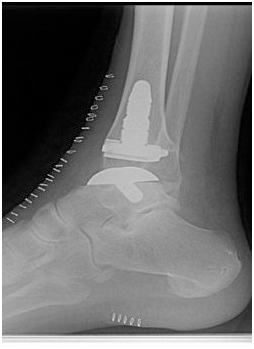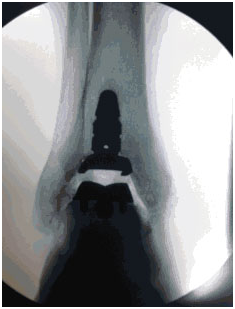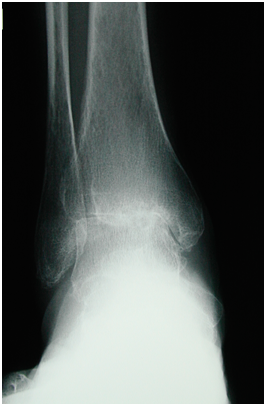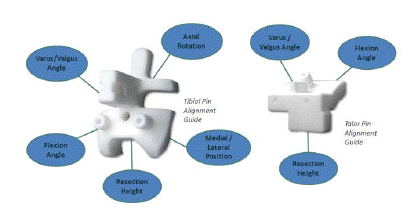(877) 977-1443
Conditions
- Ankle Arthritis
- Ankle Ligament Tear (Sprain)
- Ankle Fractures (Broken Ankle)
- Flat Feet
- Tarsal Coalition
Advanced Treatments
- Regenerative Medicine
- Ankle Arthroscopy
- Total Ankle Replacement
- Ankle Fusion
- Ankle Cartilage Replacement
- Custom Orthotics
- Physical Therapy
- Lifestyle Changes
Education and Articles
Trusted Podiatrists

Ankle Replacement
Total ankle replacement or Total ankle arthroplasty
Total ankle replacement or ankle arthroplasty is a procedure used to replace the joint surfaces of the ankle with an implant. There are 3 components of an ankle implant: a metal talar and tibial component that attaches to the ankle bones, and a plastic spacer placed into an arthritic ankle joint between the two metal components. These implants allow for motion to be maintained after the procedure and in some cases may increase the motion in a very arthritic ankle joint.

Ankle replacements can be performed on patients of any age depending of activity level and typical daily needs but are recommended for patients older than 50 with relatively less active lifestyle. With advancements in ankle replacement, the age requirement and activity level has improved and more active patients who do not have high stress jobs or activity needs can have successful ankle replacement surgery. There are many types of implants available on the market, each with its pros and cons. The doctors of The Ankle Arthritis Institute at UFAI are experts in all the approved types of ankle replacement options which allows them to select the best option for each patient and customize the surgery to the needs of the selected patient.
Watch a Real Total Ankle Replacement Surgery using the In Bone Implant:
InBone (Wright medical)
The InBone total ankle replacement implant is a fixed-bearing implant designed with stability in mind. This implant has a long stem that goes up into the leg bone (tibia) and allows for greater stability, reducing the chance that the implant may shift and fail. The design of the implant allows for better fixation to the patient's bone, which is particularly important in patients with slightly weaker bones, larger patients or patients who have a more active lifestyle. The stability of the implant allows it to be very durable as well.
Additionally, this implant is able to help correct certain angular deformities that may be present in the ankle. This implant system uses a leg frame that allows the surgeon to correct possible deformities in the ankle before making any bone cuts.
An update to the InBone system is the InBone Prophecy Implant. This implant is currently the most advanced ankle replacement system on the market and very few surgeons are trained or allowed to perform it. A computerized scan of the ankle and knee are performed and the scans are used to assess the damage to the joints, the level of deformity and a custom cutting guide and implant are designed for each individual patient. This allows for an improved fitting system and better surgical planning. The surgery time is dramatically reduced which decreases pain, decreases infection rates and improves proper implant placement and overall function.
 Side view of ankle post replacement with In Bone System
Side view of ankle post replacement with In Bone System
 The In Bone Prophecy guidance system custom made for each ankle replacement patient
The In Bone Prophecy guidance system custom made for each ankle replacement patient
 Post ankle replacement with correction of angular deformity with In Bone Ankle Replacement
Post ankle replacement with correction of angular deformity with In Bone Ankle Replacement
 Ankle Arthritis
Ankle Arthritis
 Example of In Bone Prophecy System with different angular correction options designed for each specific patient's needs and custom made on a per patient need.
Example of In Bone Prophecy System with different angular correction options designed for each specific patient's needs and custom made on a per patient need.
S.T.A.R. (Small bone innovations)
 The Scandinavian total ankle replacement (S.T.A.R.) prosthesis is the only mobile bearing implant that is approved for use in the United States. In this implant, the plastic spacer is not attached to either tibial or talar components, but rather floats in between the two. This design allows for some side to side motion or what is termed varus and valgus tilt. Due to this, there is a reduction of stress through the adjacent in the foot which may prevent arthritic changes in the future. The STAR system is used in patients who may have arthritis of the surrounding joints of the ankle and those requiring a low profile implant. This implant also covers the entire talus surface which is best for patients with severe arthritis of the talus or a poorly managed or damaged talus. The low profile implant also allows for further replacement in the future to an InBone should the need arise. The mobile bearing model has been shown to give some additional motion but there is still debate if this additional motion is beneficial.
The Scandinavian total ankle replacement (S.T.A.R.) prosthesis is the only mobile bearing implant that is approved for use in the United States. In this implant, the plastic spacer is not attached to either tibial or talar components, but rather floats in between the two. This design allows for some side to side motion or what is termed varus and valgus tilt. Due to this, there is a reduction of stress through the adjacent in the foot which may prevent arthritic changes in the future. The STAR system is used in patients who may have arthritis of the surrounding joints of the ankle and those requiring a low profile implant. This implant also covers the entire talus surface which is best for patients with severe arthritis of the talus or a poorly managed or damaged talus. The low profile implant also allows for further replacement in the future to an InBone should the need arise. The mobile bearing model has been shown to give some additional motion but there is still debate if this additional motion is beneficial.
Salto-Talaris (Tornier)
The Salto-Talaris ankle replacement implant has mobile-bearing features but is actually a fixed-bearing device. The Salto-Talaris implant mimics the anatomy of the ankle to recreate the normal flexion, extension, and rotational motions of the ankle. Due to this feature, this implant allows some degree of reduction of stress through the adjacent joints of the foot like the S.T.A.R. implant, but it is slightly more stable due to its fixed-bearing nature. However, it is difficult to correct ankle deformities with this implant. The Salto-Talaris implant is the most low profile of all implants and is usually used in very low activity patients. With the advent of the STAR implant, this implant has fallen out of favor with our group and is rarely required.
 The Salto Talaris ankle replacement pre and post implant placement. Not low profile
The Salto Talaris ankle replacement pre and post implant placement. Not low profile
The Agility Depuy Implant
The Agility Implant was one that we never implanted but have included for completeness. This implant required fusion of the tibial and fibular (the long bones in the leg) and the talus component was poorly designed and failed. Due to the poor design rationale, our surgeons never felt comfortable placing this implant and never used it. Today, the Agility implant is seldom or never used any longer even though advanced versions were made. A failed Agility implant can be changed to the InBone ankle implant.
Conclusions
Ankle replacement procedures and implants are continually being improved and more research is being done to show the efficacy and durability of all implants. There are many implants that are available to use for ankle replacements, but choosing the best implant for each patient is necessary for the most successful outcomes. The Ankle Arthritis Institute at University Foot and Ankle Institute is at the forefront of ankle replacement surgery and has expertise in all three types of currently used ankle replacements. We pride ourselves on picking the right implant for the right patient and solving their arthritis needs. Through our integrated team of surgeons, therapists and imaging experts, we take pride in finding the right implant and right option for each individual patient and their needs and requirements. From the initial visit, to expert diagnostic testing, skilled surgery and customized physical therapy services, we will take care of all your needs and requirements in a timely and family friendly manner.




